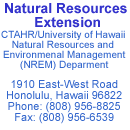


|
|
||||||||||||||||||||||||||||||||
| Project Name: | Cover Crops for Erosion Control in Ko'olaupoko |
| ASO Log No.: | PRC99-01 |
| Start/End Date: | December 1999 to June 2002 |
| Federal Funds: | $11,000.00 |
| Matching Funds: | $14,000.00 |
| Contractor: | Nick Dudley Hawaii Agriculture Research Center (HARC) 99-193 Aiea Heights Drive, Suite 300 Aiea, Hawaii 96701 Phone: 808-486-5334 Fax: 808-486-5020 |
| Background/ Overview: |
The shift from large-scale plantation agriculture to diversified agriculture and forestry is occurring with clean-tilled site preparation as a standard practice. This can lead to runoff of sediments, nutrients, and herbicides into surface and ground waters. At present, there is no recommended groundcover for use in the establishment of agroforestry systems or tree farms in Hawaii. |
| Objectives/Goals: | To provide soil protection using cover crops. Specifically, the project’s goal was to identify effective ground cover species to reduce soil erosion and other impacts for established Acacia koa demonstration sites located in Koolaupoko Watershed. |
| Methods Employed: | This project was successful in showing the benefits of establishing effective cover crops as a means to reduce soil loss from agroforestry lands. Nine ground covers (grasses and legumes) were examined during the trial periods. Native grasses (Pili and Emoloa) proved to be the most effective cover crops. Thirty days after the establishment of these ground covers, it was estimated that the soil loss from each trial was reduced by more than 90% using Pili grass and 50% using Emoloa grass instead of standard weed cover. When compared to bare ground, these grasses reduced soil loss by more than 97%. After 60 days, the Pili grass remained an effective cover crop continuing to reduce soil erosion by more than 34%. Also, Koa tress grown in conjunction with Pili and Emoloa grass were much taller and heartier after 60 days. |
| Pollutants of Concern: | Not identified in report |
| Watershed: | Koolaupoko Watershed and Kaiaka-Waialua Watersheds, island of Oahu |
| Size of Project: | Not described in report |
| Affected Water Bodies: | Not identified in report |
| Deliverables: | Not identified in report |
